DHT Hair Loss: All You Need to Know
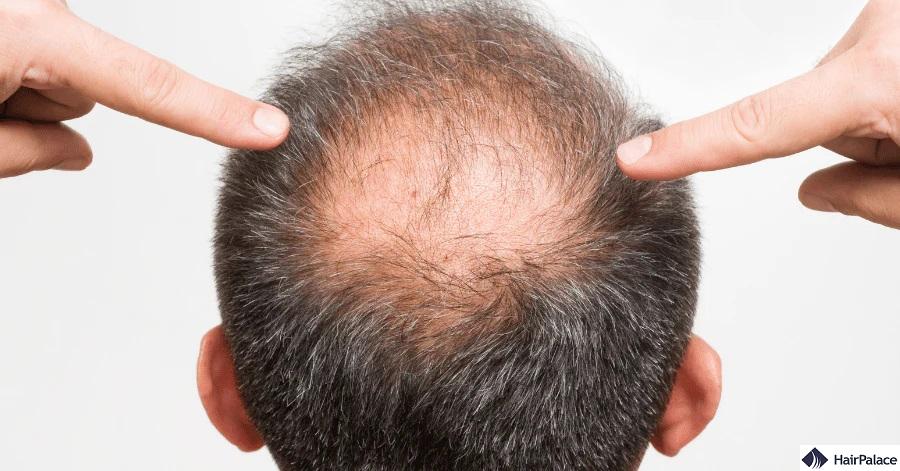
Dihydrotestosterone, often shortened as DHT, is a naturally occurring male sex hormone found in both men and women.
It is often closely linked with one of the most common hair loss conditions worldwide, androgenetic alopecia.
If your hair is beginning to thin and fall out early, or you have a family history of male pattern baldness, you need to know about the signs, symptoms, and treatment options available for DHT.
This article will demystify everything you need to know about DHT.
We’ll explain the science quickly and easily and highlight several treatments to help you manage symptoms.
With our help, you’ll be able to make an informed decision about how best to help your ailing hair.
- What is DHT?
- Signs
- Is it reversible?
- Treatment options
- Side effects
- Other hair loss causes
- Conclusion
DHT defined – what exactly is it?
Firstly, DHT is a hormone found in both men and women. It begins life as testosterone but is converted into DHT by the enzyme 5-alpha-reductase (5-AR).
DHT is a much more concentrated form and is responsible for developing a host of traditionally male attributes. These include:
- Growing extra body and facial hair
- Growth and development of male genitals
- How fat is distributed
- Deep voice
- Increased muscle mass
Up to 10% of an average adult’s testosterone will be converted to DHT.
The interaction of DHT and body hair serves an important function but when we combine DHT and hair it leads to thinning and baldness.
Despite its important function and promoting increased body and facial hair growth, DHT can negatively affect scalp hair.
This is because when DHT attaches itself to hair follicle receptors, it gradually shrinks the size of the follicle, disrupting the hair’s natural growth cycle.
Over time, the follicle will begin to fail and stop growing new hair strands, leading to developing the condition we now call androgenetic alopecia, or male and female pattern hair loss.
DHT levels don’t just affect appearances, either. Studies have linked irregular DHT levels in the body to an enlarged prostate, potentially leading to an increased chance of prostate cancer.
As such, monitoring your levels is essential for your general health, not just your hair.
Can low DHT lead to problems?
Because we often focus on high levels of DHT being linked to damaging hair, we overlook the problems that can occur with having too low a levels in your bloodstream.
Low DHT levels in the body can delay puberty in males and females.
Males, in particular, can also suffer from uneven body fat distribution, including gynecomastia (enlarged male breasts) and delayed growth and development of the penis or testicles.

Why do people react differently to DHT?
Every person’s physiology is unique, and DHT affects people differently.
Some people can deal with high levels better, while others are more susceptible to adverse reactions.
Studies have shown that DHT’s effect on a person’s hair follicles can be more substantial if that person has a family history of female or male pattern baldness.
If either one of your parents shows signs of hair thinning or early loss, this can imply you, too, will go through a similar experience.
Other factors can influence DHT’s effect on a person, including head shape, size, haircare practices, and lifestyle choices like smoking, poor diet, and lack of exercise.
Lastly, while DHT tends to primarily be an issue for men, DHT female hair loss also occurs in certain women with a genetic predisposition.
The role of 5-alpha-reductase
The enzyme 5-alpha-reductase is responsible for turning regular testosterone into DHT.
Understandably, if you have high levels of this enzyme, your body will convert more testosterone into DHT, thus increasing its effects.
There are two types of enzymes to be mindful of, with one, in particular, being held as the main culprit in causing early loss of hair:
- Type 1 of DHT is found in sebaceous glands, which help produce lubricant to keep our skin hydrated and healthy.
- Type 2 of DHT is found in the genitourinary tract and inside hair follicles. Type 2 plays a more crucial role in developing hair conditions.
What are the differences between testosterone and DHT?
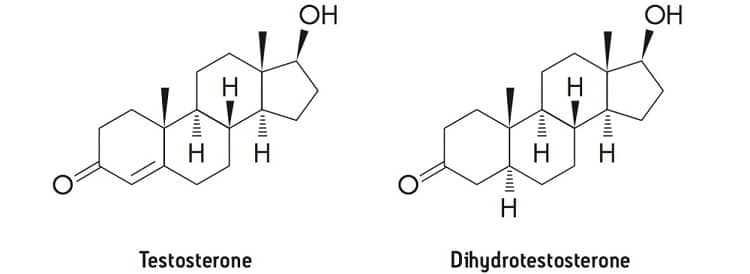
Testosterone and DHT have a close relationship in the body, but understanding their differences and core functions can help you better understand how DHT blockers work.
In the male body, testosterone is an important androgen (sex hormone), which helps develop a range of things, including:
- Managing the production of sperm
- Regulating mood and emotions
- Optimizing the distribution of fat
- Maintaining healthy muscle mass and bone strength
- Managing androgen hormone levels in the body.
DHT is an androgen hormone that stimulates the development of male characteristics, including facial, body, and pubic hair. It is derived from testosterone but is far more powerful.
While high levels of DHT can increase body hair density, it has adverse effects on scalp skin and hair, causing follicle shrinkage and prompting early shedding.
This is why DHT and hair loss are often paired together.
Signs of DHT hair loss
To understand how DHT can affect your hair, you must first understand how hair grows.
Four stages are involved; a normal cycle can last anywhere from 2 to 6 years on average. Different hair can be at different stages at different times.
The four stages of the hair growth cycle are:
- The Anagen phase is the first stage of hair growth, where cells in the hair root rapidly divide to form new hair.
- The Catagen phase is a transitional phase, where hair growth slows down and eventually stops. The hair follicle begins to shrink.
- The Telogen phase is the resting phase, where hair neither grows nor falls out. It can last up to 3 months, during which new hair begins to develop underneath.
- The Exogen phase is the final stage of the hair growth cycle and sees hair finally shed and hair falls out. You stand to lose up to 50-100 hairs a day, at which point the follicle returns to the anagen phase and forms a new hair strand.
High levels of DHT shorten the hair’s natural growth cycle, leading to premature loss and extended periods of no growth.
It binds to androgen receptors in the body and each affected DHT hair follicle shrinks to such a degree they are unable to produce new hair.
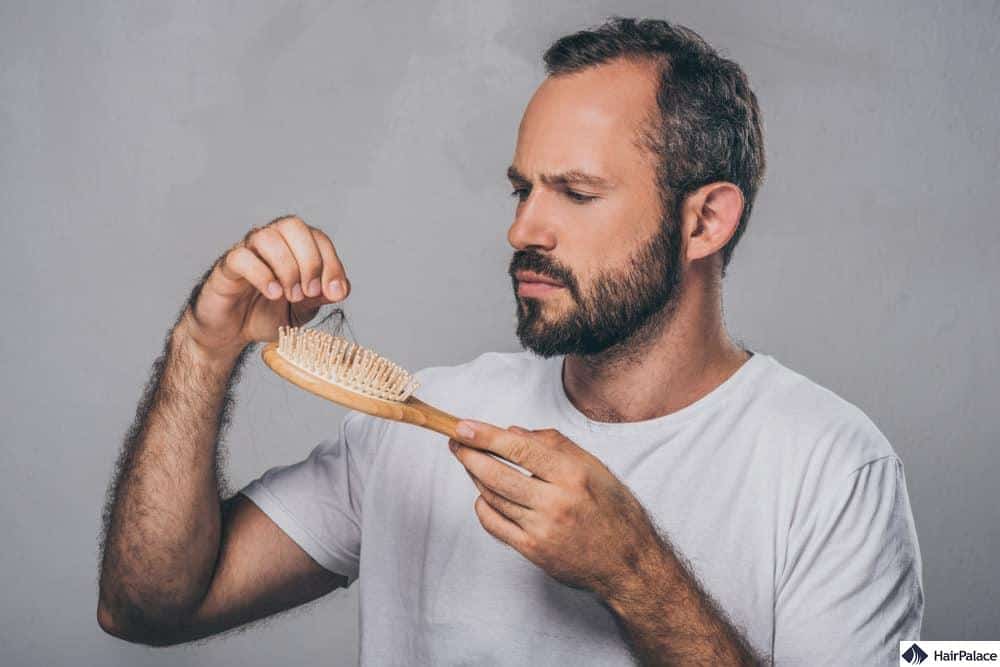
The role of genetics in male pattern baldness
Genetics is one of the most influential factors in developing hair loss conditions like female or male androgenetic alopecia.
Some people have strong genes that allow them to keep a full head of thick, healthy hair into their late 50s, 60s, and even 70s.
Other people aren’t so lucky and can experience dramatic loss as early as their teenage years or 20s.
So how can you tell if your genes make you vulnerable?
Sadly, research is still ongoing to determine which genes are the culprits. It’s thought that over 250 genes may play a part in how and if we develop a condition.
Because we inherit genes from parents, many people can estimate if they will develop androgenic alopecia based on if family members experienced similar conditions.
Can you reverse this type of hair loss?
A DHT blocker can help slow down the adverse effects of DHT and sometimes even stop it entirely.
For this reason, you should use DHT blockers as soon as possible to reduce further hair loss.
That said, it’s important to remember that when you block DHT, it is preventative more than anything else; don’t expect them to help with promoting hair growth.
Some patients have noted that the treatments can improve the appearance of existing hair, making them thicker and more robust-looking.
9 Treatment options to reduce DHT levels and slow/stop hair loss
Two types of medications aim to tackle DHT-related conditions; a DHT blocker and a DHT inhibitor.
- DHT Blockers aim to prevent the hormone from influencing receptors in the cell and shrink hair follicles.
- DHT Inhibitors target the production of the hormone in the body and reduce its presence within cell tissue.
Below are some of the most common and effective treatments prescribed for DHT-related hair loss:
1. Minoxidil
It works as a direct vasodilator, opening blood vessels and allowing blood to flow easily around the body.
This, in turn, improves circulation, reduces inflammation, and enables cells around your body to become better nourished.
That said, results will only last for as long as you continue applying the topical treatment.
2. Finasteride
Clinical studies suggest that finasteride is an effective DHT blocker, as upwards of 86% of men who took it reported that it helped stop further loss.
It is an oral treatment that is only available through prescription.
Like minoxidil, this hair loss treatment is not a permanent solution – once you stop, results will be lost, and hair will return to its former condition.
3. Biotin
Biotin is one of the B Vitamins with an excellent reputation for helping boost your hair.
It does so by stimulating keratin production, the protein responsible for healthy hair, nails, and skin.
You can naturally increase your biotin levels by eating nuts, seeds, certain vegetables, fish, and meat.
You can also take a biotin supplement to reach your ideal dietary intake.
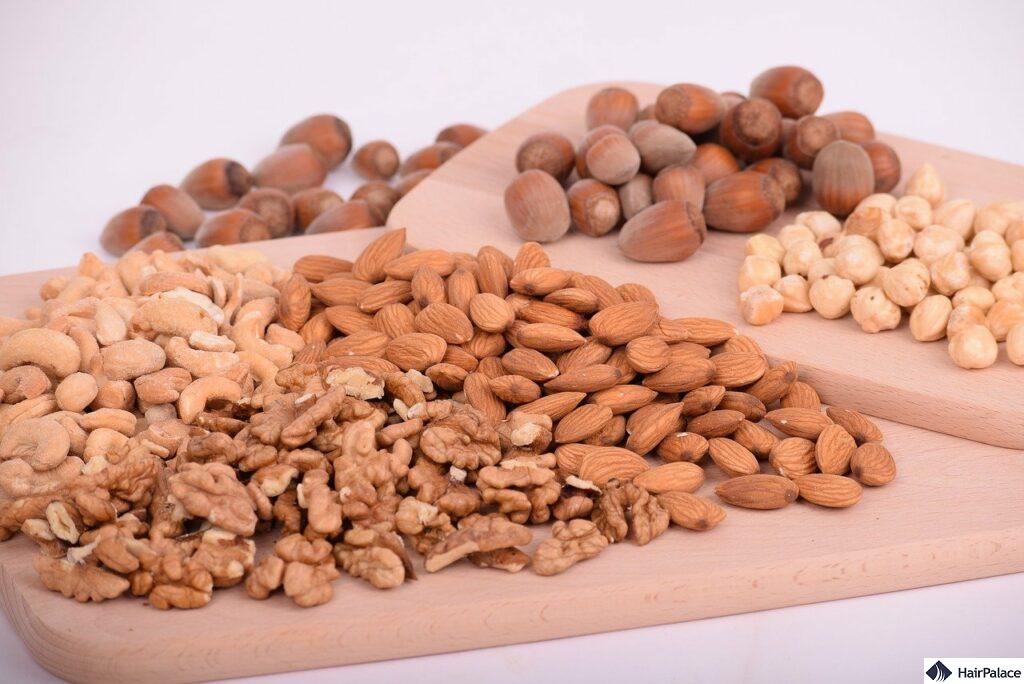
4. Pumpkin seed oil
You should consider pumpkin seed oil if you’re looking for natural DHT blockers.
It contains healthy fats and antioxidants that can help stimulate growth and limit further hair loss.
Some studies have estimated that this oil can drive up hair density by an impressive 40% after two months of continued use.
5. Pygeum bark
This herb originates from native cherry trees of Africa and is another natural, effective way to block DHT.
It works by inhibiting the enzyme 5-alpha reductase, which is responsible for producing DHT.
That said, there is not enough research available to say how effective pygeum bark can be; as such, you should be careful of its potential side effects.
6. B vitamins
Besides Biotin, there are many other useful B Vitamins that you should concentrate on increasing in your body to help support your hair.
B vitamins are essential for healthy red blood cells and an effective circulatory system.
People deficient in B vitamins may have weaker hair follicles, and hair may not grow to its potential.
Focus on increasing B 12 (Cobalamin) and B6 (pyridoxine) levels to ensure hair has everything it needs to thrive.
7. Caffeine
There is growing scientific evidence that caffeine can help hair grow thicker, longer, and more resilient.
It is often now an active ingredient in shampoos, conditions, and other topical haircare treatments.
Research studying the effects of caffeine shampoo in particular has shown it improves scalp hair, stimulating increased keratin production, and extending the growth phase of hair in patients.

8. Red light therapy
Though still a new technology and research are ongoing to measure its efficacy, low-level laser light therapy may have promising results in helping to prevent early loss of hair.
This therapy can be delivered through various devices, including hats and caps emitting constant red LED light.
This light is thought to reduce inflammation, improve blood flow, and allow your scalp to receive all the nourishment it needs.
9. Platelet-rich plasma
Platelet-rich plasma, or PRP, is when concentrated amounts of a patient’s platelets are reinjected back into their body.
They are believed to help speed up cell recovery and stimulate new cells to grow.
Some studies have affirmed that PRP can help treat various hair loss conditions, including male pattern hair loss.
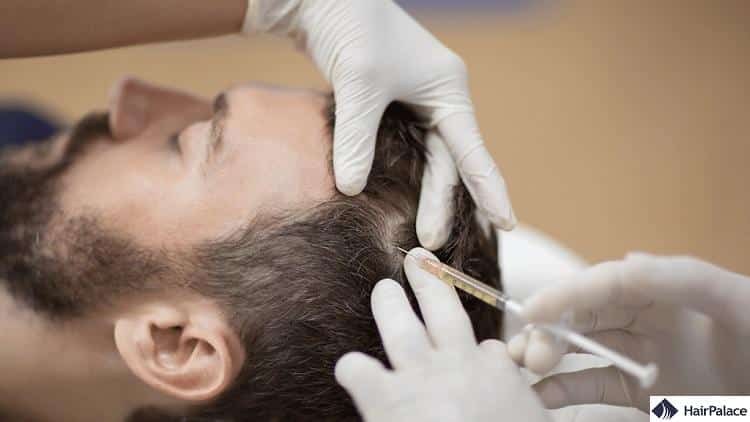
Can DHT blockers cause side effects?
Like any treatment, some side effects can arise from using these treatments.
You should always ask your doctor or dermatologist for advice on whether a treatment suits you.
Side-effects include:
- Erectile dysfunction (ED)
- Premature or delayed ejaculation
- Increased facial and upper body hair
- Hair can become darker and denser
- Rashes
- Nausea
- Vomiting
- Increased fat around the chest or breasts
- Potential heart problems as a result of water or salt retention
What else can trigger further hair loss?
DHT is just one cause of hair loss. There are other conditions and reasons for hair falling out earlier than expected. These include:
Thyroid issues
The thyroid is a gland that produces essential hormones that regulate normal bodily functions.
Several conditions relating to your thyroid can also cause hair shedding.
Producing too much or too little of a hormone can have a knock-on effect on your hair, resulting in premature hair loss.
Alopecia areata
This autoimmune condition sees patchy bald spots develop across your scalp because your immune system mistakenly attacks your healthy hair follicle cells.
Although scientists cannot say what causes alopecia areata, it’s thought to be triggered by genetic and environmental factors, like high stress levels.
Celiac disease
Celiac disease is another autoimmune condition triggered by gluten intolerance.
It can lead to hair loss because patients might suffer from vitamin and nutrient deficiencies, increased stress levels, and hormone imbalances.
Bamboo hair
Also known as trichorrhexis invaginata, bamboo hair is a genetic disorder with severe consequences for your hair.
Affected strands become segmented, produce nodules or ridges, and knot together, similar to the bamboo plant.
The condition disrupts the normal hair growth cycle, resulting in early shedding and hair loss.
Lichen planus
Lichen planus is an autoimmune condition that causes inflammation in the skin.
Hair follicles on your scalp will become damaged, sprout red bumps, and early hair loss will be triggered.
Scalp infections
Infections can cause massive irritation to your body, especially to the hair on your scalp.
Fungal infections often disrupt the natural hair growth cycle, leading to increased hair thinning, stagnation, and eventual hair loss.
How to find the ideal treatment
One of the most effective ways of correcting hair loss from DHT is through a hair transplant.
This simple, effective procedure uses your hair to restructure and restore everything from a receding hairline to bald spots and more for long-lasting results.
Certain medications can also help regulate and inhibit DHT production in the body.
This, in turn, reduces the hormone levels found in the body, limiting its potency.
You may also try natural treatment alternatives such as any hair vitamins with DHT blocker or implement foods such as almonds, berries and eggs into your diet.
However, you should keep in mind that these alternative treatment options have a very low likelihood of succeeding.
DHT Hair Loss FAQ
Lowering DHT can help stop the progression of hair loss and may promote regrowth in individuals with androgenic alopecia. However, the extent of regrowth varies from person to person.
DHT can also affect women’s hair. Elevated levels of DHT can contribute to female pattern hair loss. However, the pattern of hair loss in women due to DHT sensitivity is typically diffuse thinning across the scalp, rather than the receding hairline seen in men.
The transplanted hair is unaffected by this hormone because it’s taken from areas of the scalp that are naturally resistant to DHT.
In some cases, DHT blockers like finasteride can cause a phenomenon called “shedding” in the initial stages of treatment. This temporary increase in hair loss usually subsides after a few weeks to months as the hair growth cycle stabilizes.
DHT binds to receptors in DHT-sensitive hair follicles, causing them to shrink over time, which weakens the hair shaft and eventually leads to permanent hair loss.
DHT causes hair thinning in individuals who have a genetic predisposition to DHT induced hair loss.
No, low DHT is not typically associated with hair loss; it’s elevated DHT that’s linked to hair thinning in those with DHT-sensitive follicles.
For natural treatment, many people use remedies like saw palmetto and pumpkin seed oil, which are believed to reduce DHT levels. Additionally, maintaining a balanced diet and incorporating scalp massages can promote hair health.
Last medically reviewed on July 25th, 2024
- Urysiak-Czubatka I, Kmieć ML, Broniarczyk-Dyła G. Assessment of the usefulness of dihydrotestosterone in the diagnostics of patients with androgenetic alopecia. Postepy Dermatol Alergol. 2014 Aug;31(4):207-15. doi: 10.5114/pdia.2014.40925. Epub 2014 Sep 8. PMID: 25254005; PMCID: PMC4171668.
- DHT and hair loss. (n.d.)http://hairloss.org/hair-loss-articles/dht-and-hair-loss/
- Dihydrotestosterone. (2018).http://www.yourhormones.info/hormones/dihydrotestosterone.aspx
- Guo EL, et al. (2017). Diet and hair loss: Effects of nutrient deficiency and supplement use.https://www.ncbi.nlm.nih.gov/pmc/articles/PMC5315033/
- Schweikert HU, Wilson JD. Regulation of human hair growth by steroid hormones. I. Testerone metabolism in isolated hairs. J Clin Endocrinol Metab. 1974;38:811–819https://pubmed.ncbi.nlm.nih.gov/4823922
- Kaufman KD, Olsen EA, Whiting D, et al. Finasteride in the treatment of men with androgenetic alopecia. Finasteride Male Pattern Hair Loss Study Group. J Am Acad Dermatol. 1998;39(4, Part 1):578–589https://pubmed.ncbi.nlm.nih.gov/9777765
- Erdemir F, Harbin A, Hellstorm WJ. 5α reductase inhibitors and erectile dysfunction: The connection J Sex Med. 2008;5:2917–24http://www.ncbi.nlm.nih.gov/pubmed/19090946


